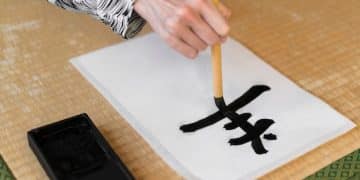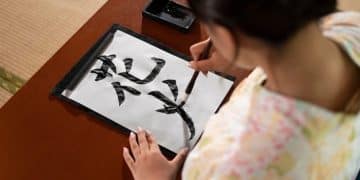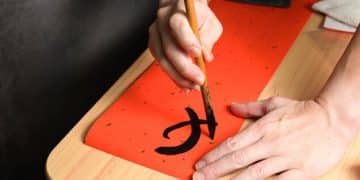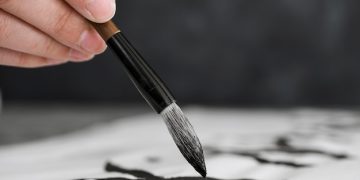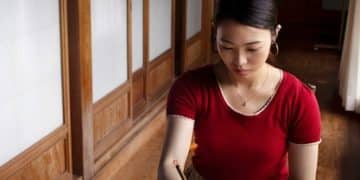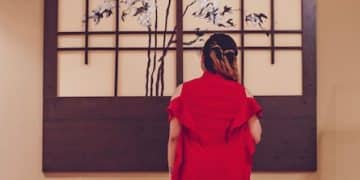Korean calligraphy art techniques: a guide to mastery

Korean calligraphy art techniques involve mastering essential tools and basic strokes, followed by exploring advanced styles to enhance creativity and develop a unique artistic voice.
Korean calligraphy art techniques invite you into a world where brushstrokes tell a story. Have you ever wondered how each character flows with grace and meaning? In this exploration, we’ll dive into the art form’s rich heritage and techniques.
understanding the history of Korean calligraphy
To truly appreciate Korean calligraphy, it’s essential to understand its rich history. This art form has evolved over centuries, combining cultural influences and techniques.
Korean calligraphy traces back to the 6th century, during the Three Kingdoms period. Initially, it was influenced by Chinese calligraphy. As time passed, unique styles emerged, reflecting Korea’s artistic identity.
Major Historical Influences
Throughout different dynasties, Korean calligraphy adapted and transformed. The Joseon Dynasty (1392-1897) played a crucial role, promoting Hangul, the Korean script. Calligraphers during this time sought to create a distinctly Korean style.
- Chinese influence in the early years
- The rise of Hangul in the Joseon Dynasty
- Modern interpretations and innovations
- Impact of cultural movements on calligraphy
As you delve deeper, you will find that each era brought new techniques and philosophies. The **beauty of Korean calligraphy** lies not just in the characters formed, but in the emotions conveyed through brush strokes. Many calligraphers view their work as a blend of art, literature, and philosophy, intertwining their personal feelings with each piece. The art form represents more than just writing; it serves as a means of expressing introspection and spirituality.
Prominent Calligraphers
Throughout history, several calligraphers significantly impacted the field. Their unique approaches have shaped modern practices:
- Kim Jeong-hui, known for his expressive brush techniques
- Seo Jae-pil, who blended traditional styles with contemporary art
- Young artists pushing the boundaries today
In learning about this history, you engage with a tradition that is not only about the skill of writing but also about understanding cultural narratives. The legacy of Korean calligraphy continues to inspire generations, ensuring that each stroke carries forward this deep-rooted heritage.
essential tools for Korean calligraphy

To start your journey into Korean calligraphy, it’s important to have the right tools. This art form requires precision and practice, and the proper instruments can make all the difference.
Several essential tools can help produce beautiful calligraphy. Each tool has its unique purpose and contributes to the overall aesthetics of the work.
Key Tools for Calligraphy
The following items are fundamental for anyone looking to excel in Korean calligraphy:
- Brushes: Bamboo brushes are traditional, offering flexibility and control.
- Ink: High-quality black ink enhances the richness of each stroke.
- Ink stone: This is where ink is ground and mixed, ensuring a smooth consistency.
- Rice paper: The right paper absorbs ink well, allowing for vivid brush strokes.
Having these tools on hand creates a foundation for practicing different techniques. A well-selected brush can influence how strokes are formed, while quality ink provides the depth needed for expressive characters. Though some may consider all inks equal, the richness of the ink plays a vital role in achieving the desired look.
Exploring Modern Options
In addition to traditional tools, contemporary artists may use synthetic brushes or even digital tablets for their designs. Though these tools differ from the classic approach, they open new avenues for creativity within Korean calligraphy. Many artists experiment with various surfaces and materials to create unique styles.
As you navigate your practice, remember to explore different tools. Your choice will influence your personal style and how you express yourself through each brush stroke. The right instruments can elevate your work and deepen your appreciation for this captivating art form.
basic techniques every beginner should know
To start your journey in Korean calligraphy, knowing the basic techniques is crucial. These skills will provide the foundation needed for more advanced styles. Many beginners find that mastering these techniques helps them express their creativity effectively.
One of the first skills to learn is how to hold the brush. The grip affects the strokes and overall quality of the writing. Begin by holding the brush at a 45-degree angle. This position allows for better control and smoother movements. As you practice, pay attention to how your hand feels and adjust as necessary.
Key Techniques to Practice
Here are some key techniques that every beginner should focus on:
- Basic Strokes: Learn to create simple lines, curves, and dots. These are the building blocks of Korean characters.
- Pressure Control: Varying pressure can create different effects. Practice applying more or less pressure for contrast.
- Character Formation: Start with simple characters. Break them down into components to understand their structure.
- Brushing Speed: Experiment with speed. A steady pace helps create more fluid strokes.
Practicing these techniques will help develop your muscle memory. Over time, you will notice improvement in your control and fluidity. As you progress, try to incorporate variations in your strokes to add personal style and flair to your work. Remember that consistency is key; daily practice yields the best results.
Building Muscle Memory
Repetition is essential for mastering these techniques. Spend time each day focusing on basic strokes and character writing. Use practice sheets to guide your movements, ensuring you develop a consistent style. As your skills grow, challenge yourself with more complex characters.
In addition to traditional techniques, consider observing experienced calligraphers. Watching their brush movements can provide insights into achieving the desired effects. Take notes on their techniques and incorporate them into your practice sessions. With dedication and time, you’ll develop a confident and unique approach to Korean calligraphy.
advanced styles to elevate your skills

As you progress in Korean calligraphy, exploring advanced styles can significantly elevate your skills. These styles will challenge you and help you develop a unique artistic voice. Each advanced technique offers new ways to express creativity and emotion through your calligraphy.
Several styles are commonly pursued by advanced calligraphers, allowing for personal expression and experimentation. Techniques such as semi-cursive and cursive scripts push the boundaries of traditional forms, offering greater flexibility and fluidity.
Popular Advanced Styles
Consider delving into the following advanced styles that can enhance your calligraphy:
- Chusok: This style is known for its thick and thin brush strokes, combining boldness with elegance.
- Modern Hangul: This approach embraces contemporary design, incorporating abstract elements while maintaining legibility.
- Watercolor Calligraphy: Mixing colors with brush techniques adds depth and vibrancy to your characters.
- Improvised Styles: Developing your own style allows for personal signature expressions and differentiating your work.
Experimenting with these styles can lead to exciting results. For instance, watercolors can create beautiful gradients, while the Chusok style provides a more traditional foundation with a modern twist. As you experiment, focus on achieving balance, harmony, and a sense of flow in each character.
Incorporating Unique Elements
Incorporate unique elements into your calligraphy for even more personal flair. Consider adding decorative flourishes or mixing materials. Using different brush sizes and ink colors during your practice sessions can yield surprising and delightful outcomes. Ensure that every new element enhances your work without compromising readability. The goal is to create pieces that are not only beautiful but also convey meaning and emotion.
As you advance in Korean calligraphy, remember that practice is essential. Set aside time each week to focus on these advanced styles. Gradually integrate what you learn into your daily practice. Each brush stroke will deepen your understanding and broaden your artistic horizons. With dedication, you can fully master these advanced techniques and bring your calligraphy to new heights.
FAQ – Frequently Asked Questions about Korean Calligraphy
What are the basic tools needed for Korean calligraphy?
Essential tools include bamboo brushes, high-quality ink, ink stones, and rice paper to create beautiful calligraphy.
How can I improve my calligraphy skills?
Regular practice of basic strokes and techniques, along with exploring different styles, can greatly enhance your skills.
What are some advanced styles in Korean calligraphy?
Advanced styles include Chusok, modern Hangul, and watercolor calligraphy, each offering unique artistic expression.
Can I develop my own calligraphy style?
Absolutely! Experimenting and mixing techniques will help you develop a personal style that reflects your creativity.
